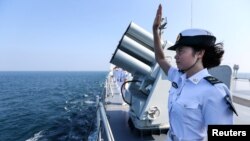Beijing has reached a new peak in its bid to control the widely disputed South China Sea after pacifying rivals, keeping Washington away and building out artificial islands that are ready for military hardware.
China will be able to keep three fighter-jet regiments on the same number of islets that it has constructed in the sea, according to a June 6 Pentagon report. China’s estimated 3,200 acres (1,294 hectares) of reclaimed land in the 3.5 million-square-kilometer sea will be used largely for military installations, a think tank forecast in March.
Joint military exercises with Russia
In another sign of tighter maritime control, Beijing’s official Xinhua News Agency said Sunday that a Chinese destroyer, frigate, supply ship and helicopter had joined Russian vessels for phase one of “complex” and “lengthy” joint military exercises that are starting in the South China Sea. Russia has the world’s second most powerful armed forces and China the third.
“I think there is an unspoken understanding that there’s no way China can be stopped,” said Collin Koh, maritime security research fellow at Nanyang Technological University in Singapore. “I think it’s a fact that China is the dominant player there other than the U.S.”
"Nine-dash line" control
China’s rise in the sea, which is claimed by five other governments, follows a year of unfettered diplomacy with those countries and a decade of landfilling some of the sea’s 500 tiny land forms to support infrastructure construction.
China will eventually decide what happens within its “nine-dash line” claim that covers more than 90 percent of the sea, said Gregory Poling, director of the Asia Maritime Transparency Initiative of American think tank Center for Strategic and International Studies. Beijing cites historic usage as a basis for the claim.
Brunei, Malaysia, Taiwan, Vietnam and the Philippines all call parts of the sea their own, overlapping the nine-dash line. They all value the sea for its fisheries, fossil fuel reserves and marine shipping lanes.
Total Chinese control
“I think the goal here is to extend a Chinese umbrella over the entire nine-dash line, which means effectively establishing administration over all of this area that China claims, including all these waters and air space they claim historic rights over,” Poling said.
“So that means if you’re a Southeast Asian fishermen or coast guard vessel or an oil and gas exploration vessel, you don’t operate unless the Chinese let you operate," he said.
Chinese diplomacy
The Communist leadership stepped up one-on-one dialogue with the militarily weaker Southeast Asian countries after a world arbitration court ruled in July against the legal basis for the Chinese claim. Beijing offers aid in exchange for muting any protest against China’s maritime military expansion, analysts say.
China offered the Philippines $24 billion in aid and investment last year. It has pumped Vietnam’s service sector with tourists while discussing maritime cooperation. Malaysia counts China as its top investor and trading partner.
US stepping back from South China Sea
Southeast Asian countries such as Vietnam and the Philippines once looked to the United States for resistance against China. Now U.S. President Donald Trump wants China’s help on stopping North Korea’s missile and nuclear programs.
“There seems to be no intention within the U.S. government in trying to craft up some form of a South China Sea strategy,” Koh said.
Southeast Asian nations aren’t pushing for one either, said Sean King, senior vice president of New York political consultancy Park Strategies.
“There’s been no coordination among the non-Chinese claimants and the only one among them that remotely has its act together on this issue, Vietnam, surely felt abandoned after America ditched the TPP, thus questioning how truly committed we are to the region,” King said.
Trump exited the TPP, or Trans Pacific Partnership, in January, calling the 12-member trade deal bad for the United States.
Signs that US will show more interest
But U.S. officials have hinted this month they will eventually take a harder line on China's maritime expansion.
In May, the U.S. Navy sent a ship on a “freedom of navigation” operation in the South China Sea despite Beijing’s objections.
“China's claim in the South China Sea needs to be handled peacefully and through negotiations, not by island-building and placing weaponry on the resulting dry land,” Defense Secretary Jim Mattis told an Asian defense conference earlier this month as quoted by the U.S. Department of Defense website.
Southeast Asian maritime claimants are keeping options open to ask Japan, India and other countries for help as needed in keeping China away, Koh said.
But today’s “cautious” Sino-U.S. cooperation, plus the specter of a more aggressive U.S. military role in the sea, should stop China from getting aggressive toward other claimants, said Andrew Yang, secretary-general with the Chinese Council of Advanced Policy Studies think tank in Taiwan.







